Migration to Australia: Refugees, Policies, and Multiculturalism
VerifiedAdded on 2021/02/19
|6
|1095
|113
Essay
AI Summary
This essay provides a comprehensive overview of migration to Australia, with a specific focus on the experiences of refugees. It begins by identifying the key drivers of migration, including inadequate human and economic development, wars, dictatorship, and land grabbing. The essay then explores the history of settlement policies in Australia, examining the impact of these policies on immigration patterns and the experiences of migrants. A significant portion of the essay is dedicated to analyzing the contributions of refugees to Australia's multicultural society, highlighting the positive impacts they have had. Finally, the essay critically examines the barriers to settlement faced by refugees, such as discrimination and limited access to essential services, offering a balanced perspective on the challenges and successes of migration in Australia. The conclusion emphasizes the historical significance of migration in Australia and the need for equitable treatment of all migrants. The assignment is supported by credible sources and is a valuable resource for understanding the complexities of migration and its impact on Australia.
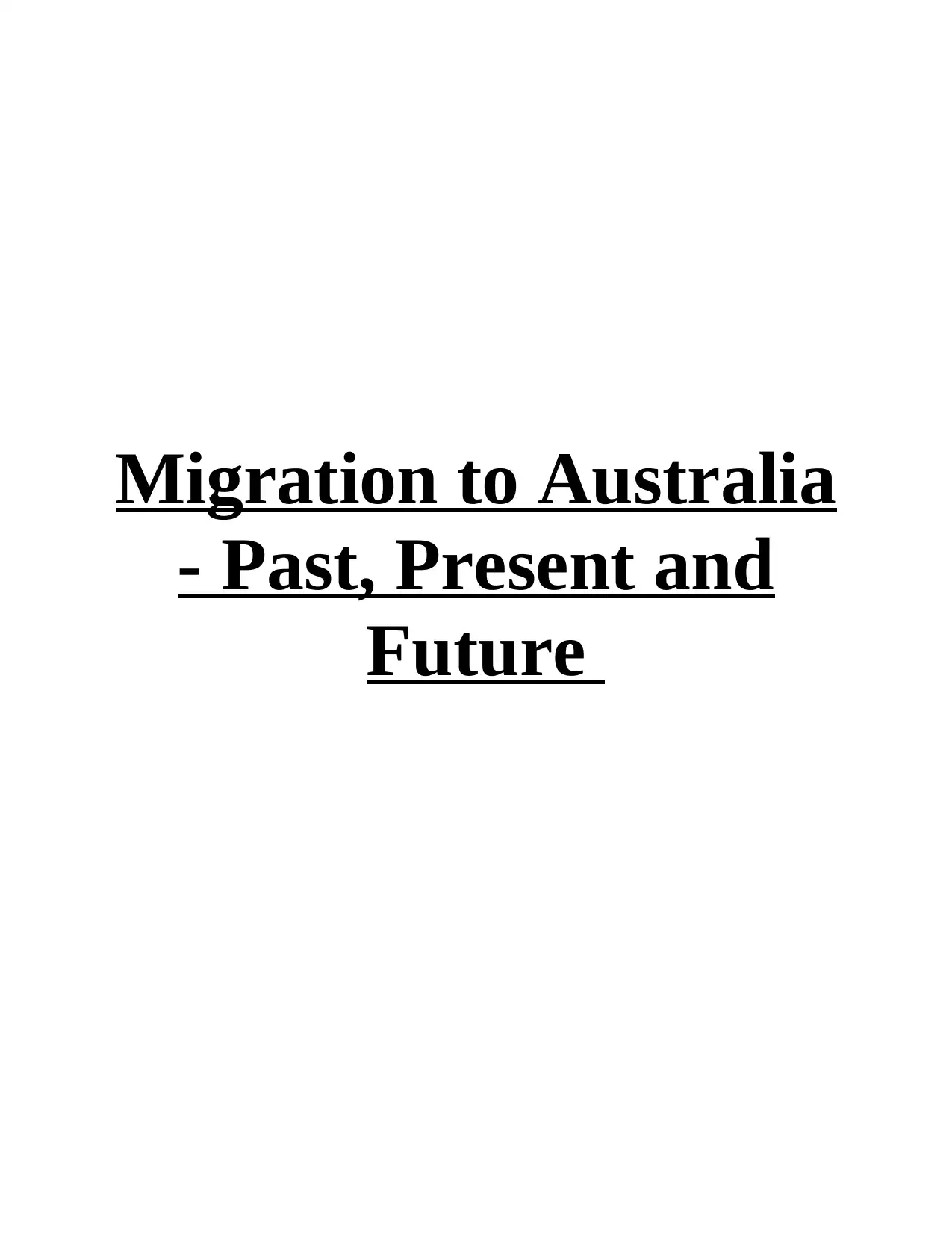
Migration to Australia
- Past, Present and
Future
- Past, Present and
Future
Paraphrase This Document
Need a fresh take? Get an instant paraphrase of this document with our AI Paraphraser
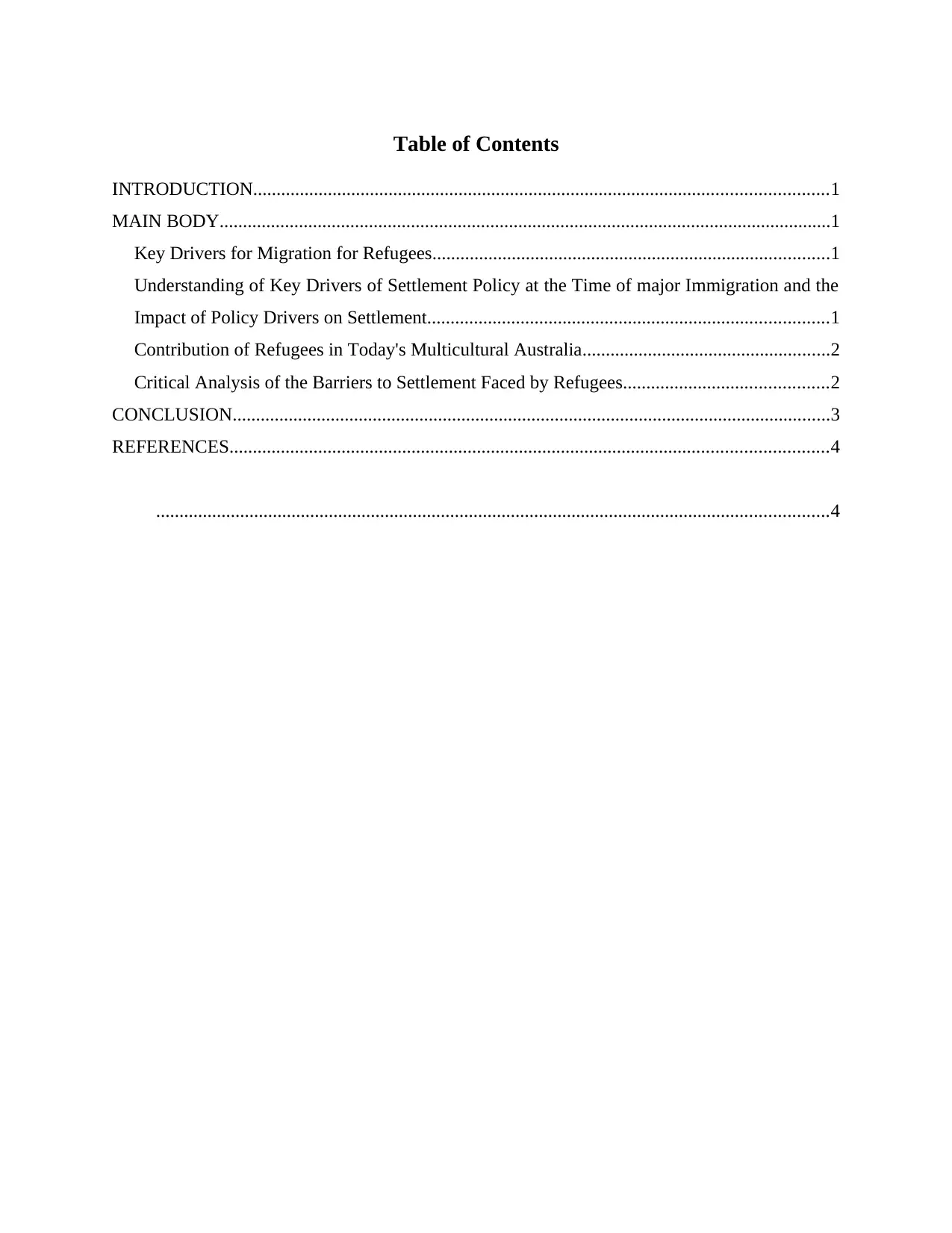
Table of Contents
INTRODUCTION...........................................................................................................................1
MAIN BODY...................................................................................................................................1
Key Drivers for Migration for Refugees.....................................................................................1
Understanding of Key Drivers of Settlement Policy at the Time of major Immigration and the
Impact of Policy Drivers on Settlement......................................................................................1
Contribution of Refugees in Today's Multicultural Australia.....................................................2
Critical Analysis of the Barriers to Settlement Faced by Refugees............................................2
CONCLUSION................................................................................................................................3
REFERENCES................................................................................................................................4
................................................................................................................................................4
INTRODUCTION...........................................................................................................................1
MAIN BODY...................................................................................................................................1
Key Drivers for Migration for Refugees.....................................................................................1
Understanding of Key Drivers of Settlement Policy at the Time of major Immigration and the
Impact of Policy Drivers on Settlement......................................................................................1
Contribution of Refugees in Today's Multicultural Australia.....................................................2
Critical Analysis of the Barriers to Settlement Faced by Refugees............................................2
CONCLUSION................................................................................................................................3
REFERENCES................................................................................................................................4
................................................................................................................................................4
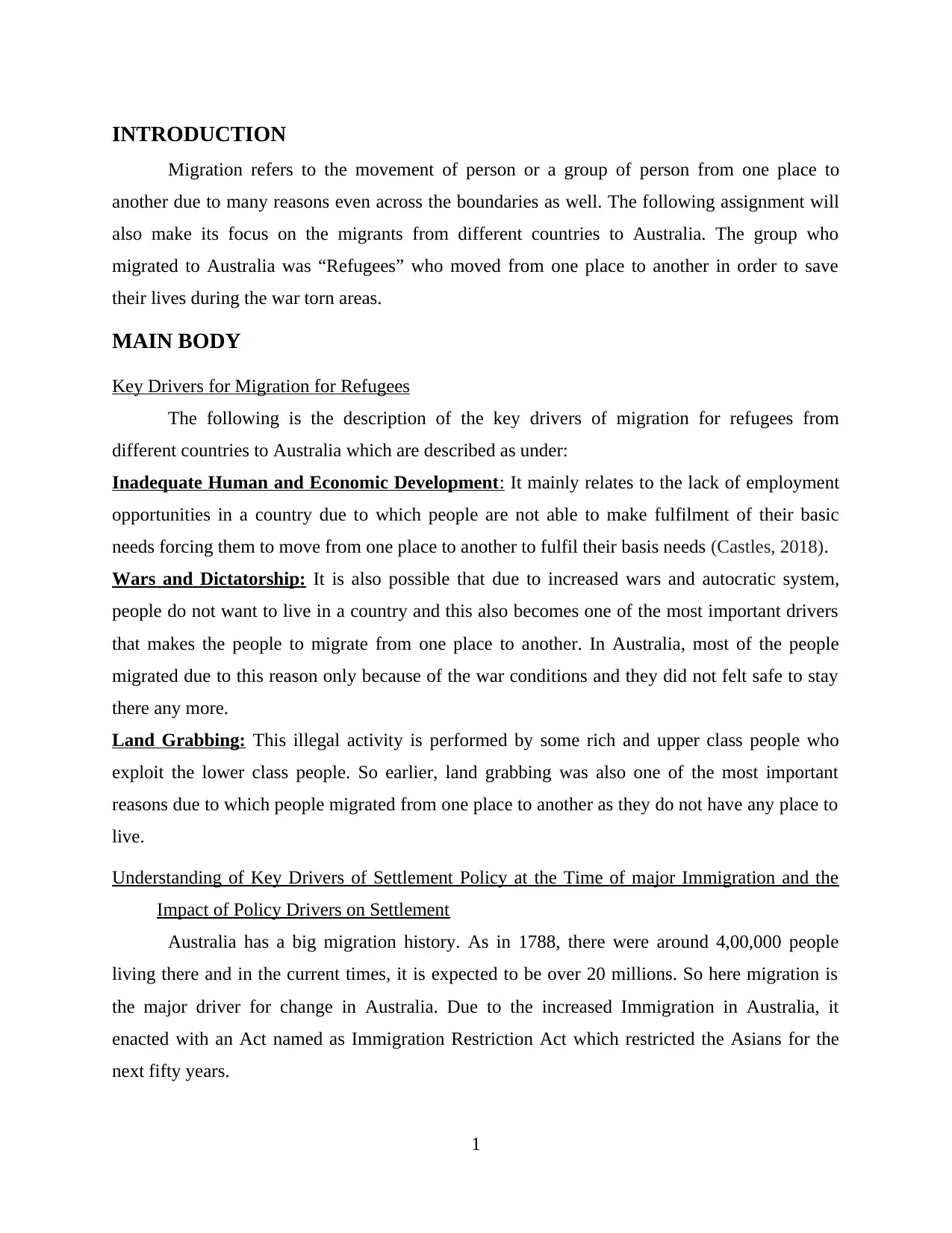
INTRODUCTION
Migration refers to the movement of person or a group of person from one place to
another due to many reasons even across the boundaries as well. The following assignment will
also make its focus on the migrants from different countries to Australia. The group who
migrated to Australia was “Refugees” who moved from one place to another in order to save
their lives during the war torn areas.
MAIN BODY
Key Drivers for Migration for Refugees
The following is the description of the key drivers of migration for refugees from
different countries to Australia which are described as under:
Inadequate Human and Economic Development: It mainly relates to the lack of employment
opportunities in a country due to which people are not able to make fulfilment of their basic
needs forcing them to move from one place to another to fulfil their basis needs (Castles, 2018).
Wars and Dictatorship: It is also possible that due to increased wars and autocratic system,
people do not want to live in a country and this also becomes one of the most important drivers
that makes the people to migrate from one place to another. In Australia, most of the people
migrated due to this reason only because of the war conditions and they did not felt safe to stay
there any more.
Land Grabbing: This illegal activity is performed by some rich and upper class people who
exploit the lower class people. So earlier, land grabbing was also one of the most important
reasons due to which people migrated from one place to another as they do not have any place to
live.
Understanding of Key Drivers of Settlement Policy at the Time of major Immigration and the
Impact of Policy Drivers on Settlement
Australia has a big migration history. As in 1788, there were around 4,00,000 people
living there and in the current times, it is expected to be over 20 millions. So here migration is
the major driver for change in Australia. Due to the increased Immigration in Australia, it
enacted with an Act named as Immigration Restriction Act which restricted the Asians for the
next fifty years.
1
Migration refers to the movement of person or a group of person from one place to
another due to many reasons even across the boundaries as well. The following assignment will
also make its focus on the migrants from different countries to Australia. The group who
migrated to Australia was “Refugees” who moved from one place to another in order to save
their lives during the war torn areas.
MAIN BODY
Key Drivers for Migration for Refugees
The following is the description of the key drivers of migration for refugees from
different countries to Australia which are described as under:
Inadequate Human and Economic Development: It mainly relates to the lack of employment
opportunities in a country due to which people are not able to make fulfilment of their basic
needs forcing them to move from one place to another to fulfil their basis needs (Castles, 2018).
Wars and Dictatorship: It is also possible that due to increased wars and autocratic system,
people do not want to live in a country and this also becomes one of the most important drivers
that makes the people to migrate from one place to another. In Australia, most of the people
migrated due to this reason only because of the war conditions and they did not felt safe to stay
there any more.
Land Grabbing: This illegal activity is performed by some rich and upper class people who
exploit the lower class people. So earlier, land grabbing was also one of the most important
reasons due to which people migrated from one place to another as they do not have any place to
live.
Understanding of Key Drivers of Settlement Policy at the Time of major Immigration and the
Impact of Policy Drivers on Settlement
Australia has a big migration history. As in 1788, there were around 4,00,000 people
living there and in the current times, it is expected to be over 20 millions. So here migration is
the major driver for change in Australia. Due to the increased Immigration in Australia, it
enacted with an Act named as Immigration Restriction Act which restricted the Asians for the
next fifty years.
1
⊘ This is a preview!⊘
Do you want full access?
Subscribe today to unlock all pages.

Trusted by 1+ million students worldwide
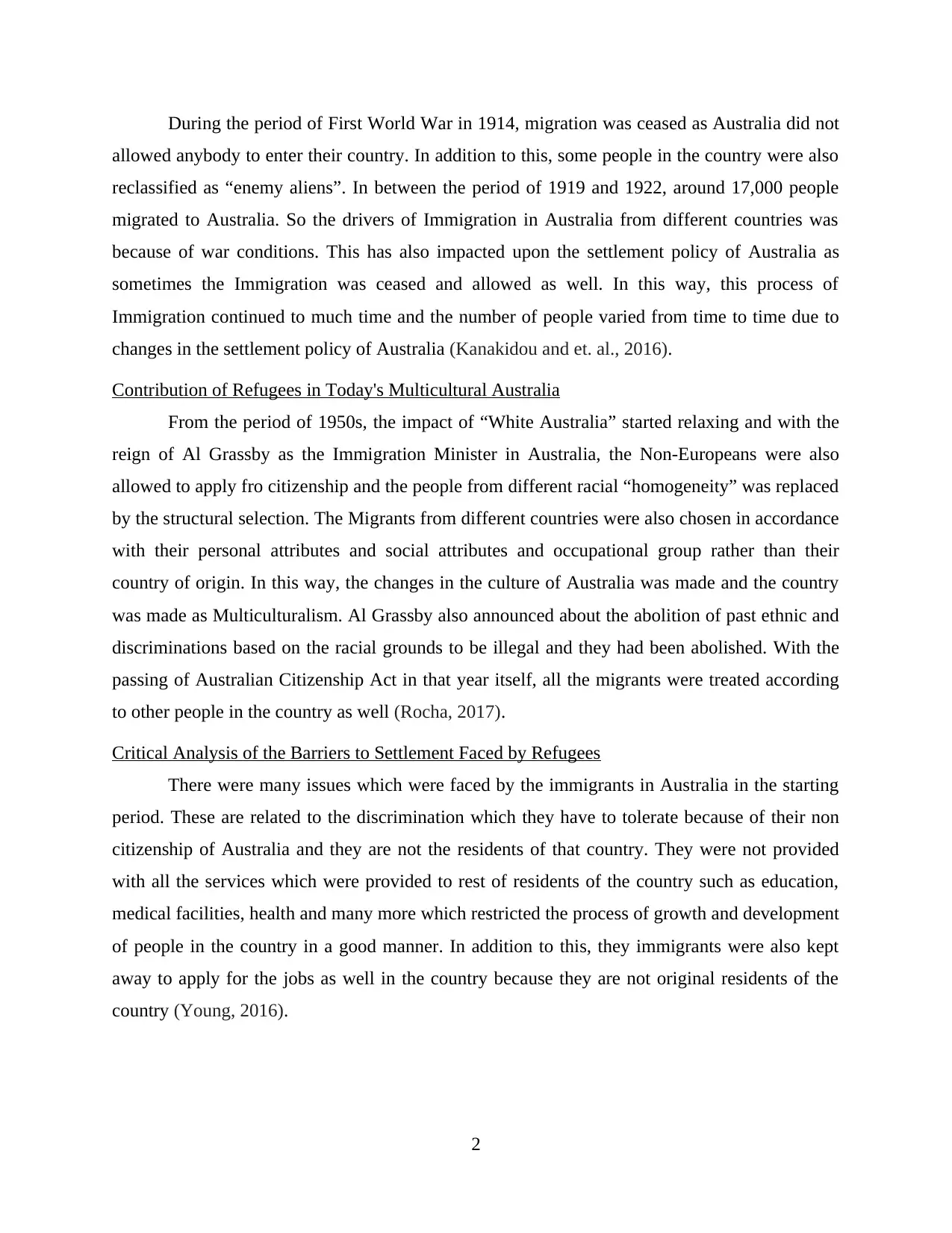
During the period of First World War in 1914, migration was ceased as Australia did not
allowed anybody to enter their country. In addition to this, some people in the country were also
reclassified as “enemy aliens”. In between the period of 1919 and 1922, around 17,000 people
migrated to Australia. So the drivers of Immigration in Australia from different countries was
because of war conditions. This has also impacted upon the settlement policy of Australia as
sometimes the Immigration was ceased and allowed as well. In this way, this process of
Immigration continued to much time and the number of people varied from time to time due to
changes in the settlement policy of Australia (Kanakidou and et. al., 2016).
Contribution of Refugees in Today's Multicultural Australia
From the period of 1950s, the impact of “White Australia” started relaxing and with the
reign of Al Grassby as the Immigration Minister in Australia, the Non-Europeans were also
allowed to apply fro citizenship and the people from different racial “homogeneity” was replaced
by the structural selection. The Migrants from different countries were also chosen in accordance
with their personal attributes and social attributes and occupational group rather than their
country of origin. In this way, the changes in the culture of Australia was made and the country
was made as Multiculturalism. Al Grassby also announced about the abolition of past ethnic and
discriminations based on the racial grounds to be illegal and they had been abolished. With the
passing of Australian Citizenship Act in that year itself, all the migrants were treated according
to other people in the country as well (Rocha, 2017).
Critical Analysis of the Barriers to Settlement Faced by Refugees
There were many issues which were faced by the immigrants in Australia in the starting
period. These are related to the discrimination which they have to tolerate because of their non
citizenship of Australia and they are not the residents of that country. They were not provided
with all the services which were provided to rest of residents of the country such as education,
medical facilities, health and many more which restricted the process of growth and development
of people in the country in a good manner. In addition to this, they immigrants were also kept
away to apply for the jobs as well in the country because they are not original residents of the
country (Young, 2016).
2
allowed anybody to enter their country. In addition to this, some people in the country were also
reclassified as “enemy aliens”. In between the period of 1919 and 1922, around 17,000 people
migrated to Australia. So the drivers of Immigration in Australia from different countries was
because of war conditions. This has also impacted upon the settlement policy of Australia as
sometimes the Immigration was ceased and allowed as well. In this way, this process of
Immigration continued to much time and the number of people varied from time to time due to
changes in the settlement policy of Australia (Kanakidou and et. al., 2016).
Contribution of Refugees in Today's Multicultural Australia
From the period of 1950s, the impact of “White Australia” started relaxing and with the
reign of Al Grassby as the Immigration Minister in Australia, the Non-Europeans were also
allowed to apply fro citizenship and the people from different racial “homogeneity” was replaced
by the structural selection. The Migrants from different countries were also chosen in accordance
with their personal attributes and social attributes and occupational group rather than their
country of origin. In this way, the changes in the culture of Australia was made and the country
was made as Multiculturalism. Al Grassby also announced about the abolition of past ethnic and
discriminations based on the racial grounds to be illegal and they had been abolished. With the
passing of Australian Citizenship Act in that year itself, all the migrants were treated according
to other people in the country as well (Rocha, 2017).
Critical Analysis of the Barriers to Settlement Faced by Refugees
There were many issues which were faced by the immigrants in Australia in the starting
period. These are related to the discrimination which they have to tolerate because of their non
citizenship of Australia and they are not the residents of that country. They were not provided
with all the services which were provided to rest of residents of the country such as education,
medical facilities, health and many more which restricted the process of growth and development
of people in the country in a good manner. In addition to this, they immigrants were also kept
away to apply for the jobs as well in the country because they are not original residents of the
country (Young, 2016).
2
Paraphrase This Document
Need a fresh take? Get an instant paraphrase of this document with our AI Paraphraser
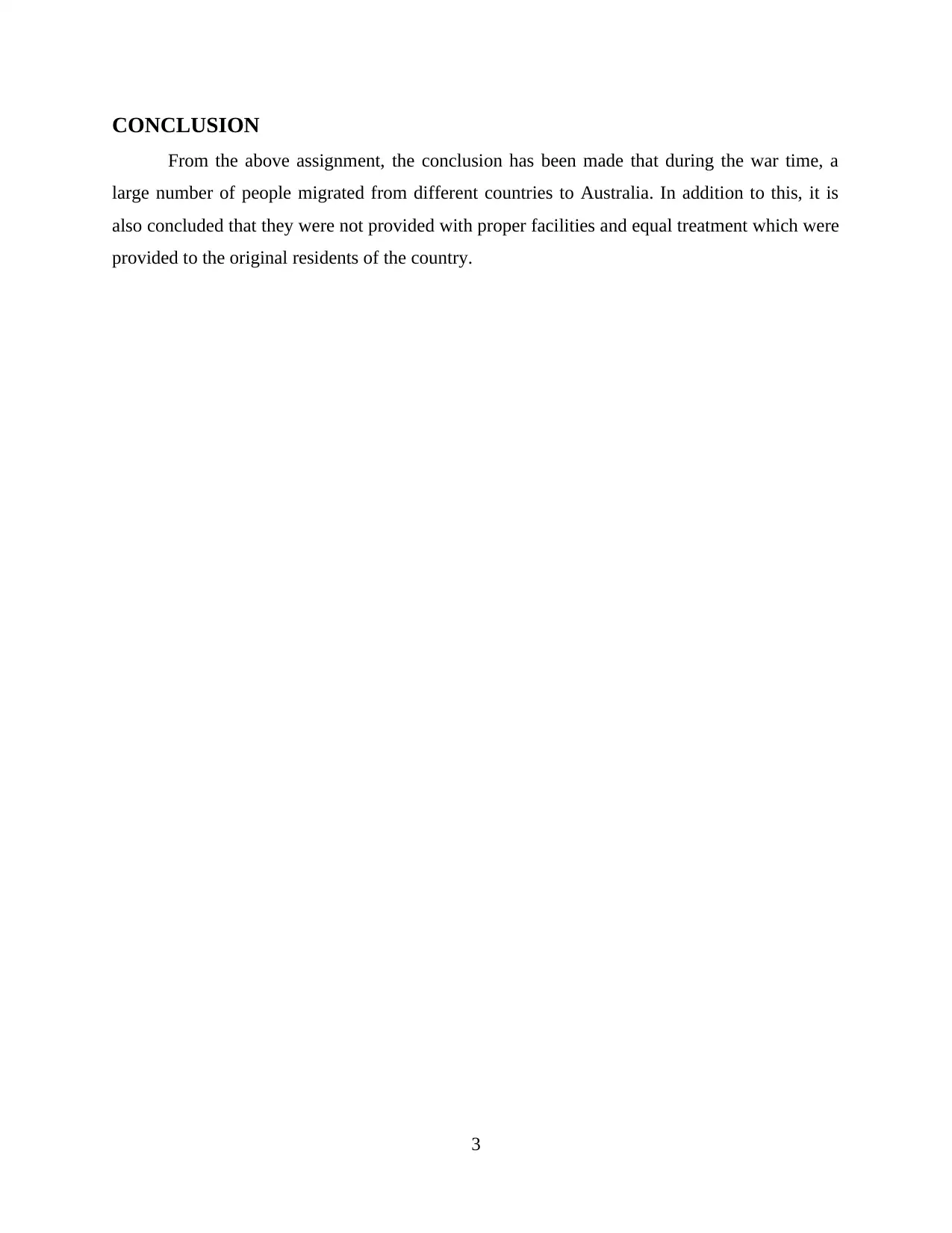
CONCLUSION
From the above assignment, the conclusion has been made that during the war time, a
large number of people migrated from different countries to Australia. In addition to this, it is
also concluded that they were not provided with proper facilities and equal treatment which were
provided to the original residents of the country.
3
From the above assignment, the conclusion has been made that during the war time, a
large number of people migrated from different countries to Australia. In addition to this, it is
also concluded that they were not provided with proper facilities and equal treatment which were
provided to the original residents of the country.
3
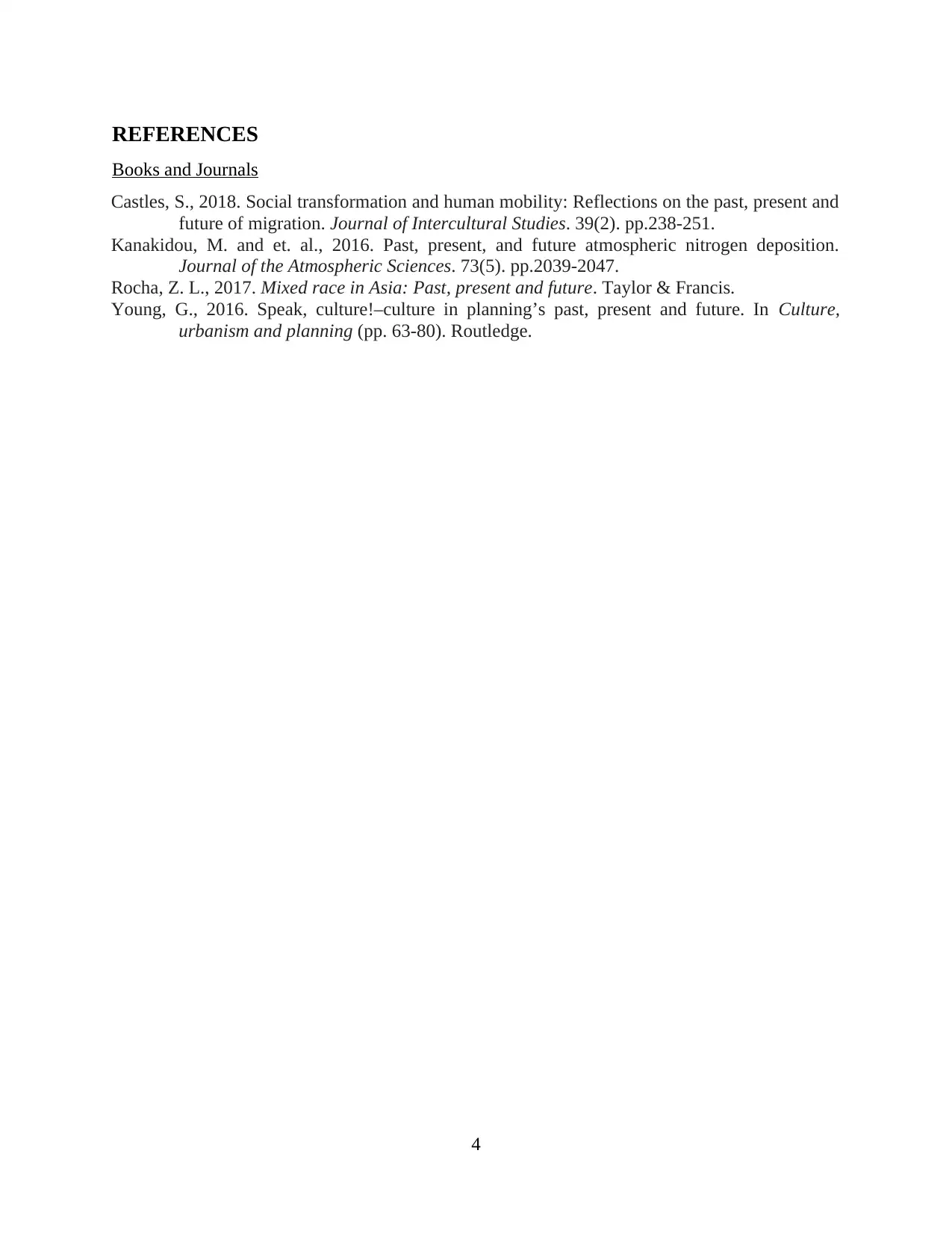
REFERENCES
Books and Journals
Castles, S., 2018. Social transformation and human mobility: Reflections on the past, present and
future of migration. Journal of Intercultural Studies. 39(2). pp.238-251.
Kanakidou, M. and et. al., 2016. Past, present, and future atmospheric nitrogen deposition.
Journal of the Atmospheric Sciences. 73(5). pp.2039-2047.
Rocha, Z. L., 2017. Mixed race in Asia: Past, present and future. Taylor & Francis.
Young, G., 2016. Speak, culture!–culture in planning’s past, present and future. In Culture,
urbanism and planning (pp. 63-80). Routledge.
4
Books and Journals
Castles, S., 2018. Social transformation and human mobility: Reflections on the past, present and
future of migration. Journal of Intercultural Studies. 39(2). pp.238-251.
Kanakidou, M. and et. al., 2016. Past, present, and future atmospheric nitrogen deposition.
Journal of the Atmospheric Sciences. 73(5). pp.2039-2047.
Rocha, Z. L., 2017. Mixed race in Asia: Past, present and future. Taylor & Francis.
Young, G., 2016. Speak, culture!–culture in planning’s past, present and future. In Culture,
urbanism and planning (pp. 63-80). Routledge.
4
⊘ This is a preview!⊘
Do you want full access?
Subscribe today to unlock all pages.

Trusted by 1+ million students worldwide
1 out of 6
Related Documents
Your All-in-One AI-Powered Toolkit for Academic Success.
+13062052269
info@desklib.com
Available 24*7 on WhatsApp / Email
![[object Object]](/_next/static/media/star-bottom.7253800d.svg)
Unlock your academic potential
Copyright © 2020–2025 A2Z Services. All Rights Reserved. Developed and managed by ZUCOL.





